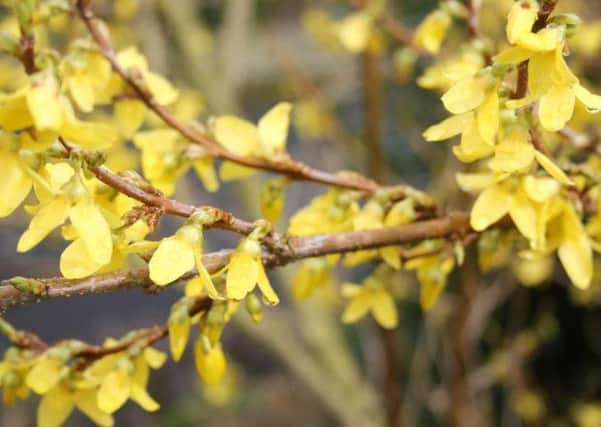Clumber Gardener: Forsythias are easy to grow and have many virtues


They are easy to grow, are fully hardy, grow at a fast rate and provide a welcome splash of early spring colour in March and April.
They can be planted in full sun or partial shade and are sometimes planted to form an informal hedge. Their downside is that summer foliage is considered rather drab and there is little variation in their flower colour.
Advertisement
Hide AdAdvertisement
Hide AdHowever, their frost-resistant flowers are certainly cheery and bright in shades of yellow, and can be combined to good effect with golden variegated evergreens such as elaeagnus, euonymus and holly and early flowering narcissi, or, for contrast, with blue bulbs such as the ever reliable Scilla sibirica or blue flowered perennials like pulmonarias ‘Blue Ensign’ or ‘Highdown’.
Forsythias will benefit from regular annual pruning.
They flower on wood produced during the previous year, so the best time to prune them is straight after they have finished flowering.
This gives the shrub the chance to produce shoots throughout the late spring and summer, which will over-winter and flower the following spring.
If pruned during the summer, much of this flowering wood would be removed and the display wouldn’t be as spectacular.
Advertisement
Hide AdAdvertisement
Hide AdThe tried and tested forsythia is the free flowering ‘Lynwood Variety’; it forms a spreading, deciduous shrub and produces yellow flowers along the entire length of its one year old stems before the leaves appear.
Ultimate height and spread are between 2m to 3m/6ft6ins to 10ft. ‘Beatrix Farrand’ has larger flowers, over 2.5cm/1ins across, and grows to a similar size,
Smaller varieties are now available. ‘Gold Mine’ (also known as ‘Mindor’) is a recent introduction.
Its stems are densely covered with flowers, making them ideal for cutting for the house.
Advertisement
Hide AdAdvertisement
Hide AdPruning out flowered shoots after flowering and cutting out a third of its older stems down to soil level will restrict its height and spread to around 1.5m/5ft. ‘Weekend Courtalyn’ can also be kept to the same size.
Forsythias’ other big plus is that they are really easy to propagate.
Long, arching shoots which bend down to the ground can be layered, a technique which encourages roots to develop on a stem before it is separated from the parent plant.
Make a cut about 2.5cm/1ins long on the bottom side of the stem where it is touching the soil, ideally about 23cm/9ins from its tip.
Advertisement
Hide AdAdvertisement
Hide AdPut a match stick in the cut, to keep the cut surfaces apart, which encourages rooting.
Make a hole about 12.5cm/5ins deep and fill with a suitable rooting medium (such as a rooting compost) and bury this section of the stem in the hole.
Keep this area watered in dry spells. If layered in the early spring, roots should have formed where the cut was made by the autumn.
The rooted stem can then be cut from the parent plant and transplanted to its new site.